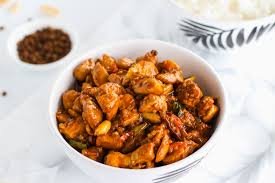The spiciness level of **Kung Pao chicken** can range from **mild to medium** depending on how the dish is prepared and how many dried chilies or chili-based ingredients are used. To understand the spiciness in full detail, it’s important to consider the following components:

1.Key Source of Spice: Dried Red Chilies
The primary source of heat in Kung Pao chicken comes from **dried red chilies**, which are typically Sichuan-style dried red peppers. The amount of heat in the dish largely depends on:
The number of dried chilies used:
Some versions use several whole dried chilies, while others might use fewer for a milder effect.
Whether the seeds are included:
The seeds of dried chilies are the most concentrated part when it comes to heat. If the chilies are left whole (including seeds), the dish will have more heat. If the chilies are cut open or the seeds are discarded, the spice level is generally lower.
Type of dried chili:
In traditional Sichuan cooking, the dried chilies used can range in heat level, from mild to very hot. This means that a particularly hot batch of dried chilies will make the dish spicier.
In general, the spiciness from dried red chilies in Kung Pao chicken is **gradual and builds over time**. Than providing an immediate, intense burn. You might not notice the full heat until you’ve taken several bites.
3.Sichuan Peppercorns: “Numbing” Sensation
In addition to the heat from the dried chilies, **Sichuan peppercorns** (a signature ingredient in many Kung Pao recipes) introduce a unique sensation known as “má” — a numbing, tingling feeling. These peppercorns don’t necessarily contribute to spiciness in the traditional sense (like chili peppers do), but they create a **tingling, mouth-numbing effect** that can make the dish feel spicier than it actually is.
Sichuan peppercorns are typically used in **small quantities**, enough to add this distinctive numbing feeling but not enough to overwhelm the other flavors. The sensation of numbing can alter your perception of heat, making the spiciness feel more intense than it might be if you were just dealing with dried chili peppers alone.
3.Adjustability of Spice
Heat Level Variability: The heat level in Kung Pao chicken can vary widely depending on who is preparing it. In authentic Chinese versions, especially those from Sichuan.The heat tends to be more intense, with a substantial amount of chilies and Sichuan peppercorns used. In **Westernized versions** (particularly in Chinese-American or Western-style Chinese restaurants), the heat is often toned down to cater to a broader palate, so it may range from mild to medium-spicy.
Personalization: If you’re making Kung Pao chicken at home or ordering it from a restaurant, you can typically ask for it to be adjusted according to your spice tolerance. Some restaurants may offer a “spice level” scale (mild, medium, hot).While others might leave it up to the chef’s discretion.
4.Spice Sensation

Initial Impact: When you first take a bite, you might experience a mild, pleasant warmth. The heat comes from the dried chilies, and the **burn** may gradually build over several bites. Specially if the dish has been prepared with a higher chili content. This is because the dried chilies are often fried in oil at the start of cooking, releasing their flavor and heat into the oil, which then coats the chicken.
Lingering Heat: The heat from the dried chilies often lingers for a while in the back of your throat. It’s not typically an overpowering burn.More of a warm, numbing sensation that stays with you as you continue eating.
Tingly Sensation: If Sichuan peppercorns are used, you’ll likely feel a **tingling** or “buzzing” sensation in your mouth. This sensation is distinct from traditional chili heat. Providing a **numbing** effect (often described as feeling “cool” or “fuzzy”) on your tongue and lips.
5.Typical Heat Range
Mild: For restaurants or versions with fewer dried chilies and a smaller amount of Sichuan peppercorns, the heat is generally **mild**. The dish might have a slight kick.The overall flavor is more about balance—savory, sweet, and tangy, with just a hint of spice.
Medium: In most Kung Pao chicken dishes, particularly those with a moderate amount of dried chilies and peppercorns, the heat level falls into the **medium** range. Expect a **noticeable spice** that grows with each bite but still remains manageable for most people.
Spicy: In traditional, spicy versions of Kung Pao chicken (such as those from Sichuan), the dish can reach a **spicy** level of heat. The combination of both **dried chilies** and **Sichuan peppercorns**. Gives the dish an intense, long-lasting burn, along with the numbing sensation. This heat may be too much for those sensitive to spice.It’s generally appreciated by those who enjoy bold, spicy flavors.
How Does Spice Affect the Overall Dish?
The spiciness in Kung Pao chicken is just one component of its flavor balance. It should be **complemented** by the other tastes:
The **sweetness** from sugar or hoisin sauce helps to **balance the heat**, preventing it from becoming overpowering.
The **savory umami** from soy sauce adds depth.The **tanginess** from vinegar helps to cut through the richness and spice.
The **crunch of peanuts** provides a textural contrast that also balances the heat with a mild, nutty flavor.
Summary of Spiciness Level:
Mild to Medium Heat:
chicken typically offers a mild-to-medium spicy experience. The heat comes from dried red chilies and possibly Sichuan peppercorns. In authentic versions, the heat can be more pronounced, while in Westernized versions, it’s generally toned down.
Numbing Effect Sichuan peppercorns provide a numbing sensation (tingling or “”).To the experience of spiciness, making the dish feel spicier than it is.
Overall Balance:
The spiciness in chicken is deliberate and balanced meant to complement the dish’s sweet, savory. Tangy elements, rather than overwhelming them.
For those who enjoy spicy food, chicken can provide a pleasant heat. But for individuals with a low tolerance for spice, the dish can be adjusted to be milder.

